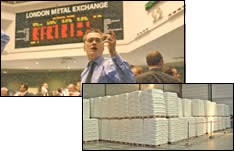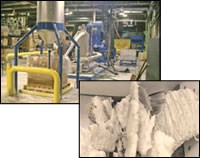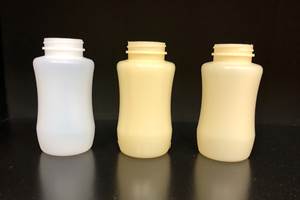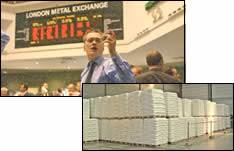Four Ways to Fight Sky-High Resin Prices
There are lots of ways to economize on resin costs, but here are four that you may have overlooked: negotiating smarter resin contracts, buying “futures,” using recycled resins, and more efficient purging aids. The main idea is to give yourself more choices, no matter what direction resin prices go.
Processors have coped for two years in an environment of escalating resin prices. Some processors have sailed through this storm virtually unscathed. The fortunate ones can pass prices through to their customers. But many processors can’t adjust prices on short notice or hike them as far and as fast as the tide of resin costs has risen.
That doesn’t mean processors are entirely helpless in the face of rising resin costs. Apart from the many routine sorts of things that can be done to reduce scrap and waste of materials, processors may have overlooked four less-familiar approaches that can soften the blow of rising prices. Two are strictly financial management approaches—negotiating more flexible and creative annual resin contracts and making use of financial hedging tools that minimize exposure to market fluctuations. The other two are more technological—using alternative feedstocks like post-consumer recycle and engineered purging agents that enable faster material and color changes.
1. Write sharper contracts
Some processors benefit from annual resin contracts that give them better pricing than competitors. Around 2000, when natural gas prices started climbing, resin producers made a push to eliminate 30- and 60-day price-protection clauses from their annual resin contracts. Gas costs became so volatile that they could spike upward and sink back down before 60 days elapsed, so resin makers never recovered the higher costs from their biggest customers.
With most 30- and 60-day protection gone, large resin buyers got themselves contracts based on a published market index, which put some delay back into pricing. Today 80% of large-volume plastic buyers pay prices based on an index, consultants estimate.
“Of those indexed contracts, 80% are standard—the index minus a percentage discount,” estimates the vice president of one major index publisher. Commonly used indexes are resin prices published by Chemical Data Inc. and Chemical Market Associates, and oil and gas prices published by ICIS-LOR and Platts Oil Gram.
“For a very large buyer there are millions of dollars at stake in managing an indexed agreement properly,” says Bill Bowie, COO of Resin Technology Inc. (RTI), a consulting firm that advises processors on materials costs. A processor is better protected if it negotiates different types of contracts with different suppliers, Bowie says. One contract could be based on an index, another on spot-market prices, a third on monomer prices, and a fourth on an index with a floor and ceiling to limit the range of movement.
One PVC siding extruder structured its contract as an average of several indexes with a variable discount. If the index price in any month exceeded the contract price for the preceding February (typically a busy month for siding), the discount would be the difference between the current price and the February price.
Bowie believes the best approach is still to sit down and negotiate with resin suppliers each month. “The best buyers in the world do it that way,” he notes. “Processors who consume 100 million lb/month may base contracts on an index but still negotiate their resin price with suppliers each month.” Index values should be taken only as a starting point, he advises.
2. Play the ‘futures’market
Financial hedges for plastics buyers have been around since at least 1997, when four companies launched over-the-counter forward contracts to buy and sell resin: Shell Petrochemical, Enron, Koch Industries, and Louis Dreyfus.
Today, Dreyfus is the only one of the original four that still writes custom forward contracts for plastics. They are based on the differential between a fixed price negotiated with Dreyfus and a published index. Such hedging still is not widely used for plastics, nor are the contracts big. The biggest contract Enron wrote was for 5 million lb/month of PE. Most of Dreyfus’ contracts are for 1 million to 2 million lb/month.
Last year, some of the companies that bought these forward contracts looked very smart indeed. “No one expected that hurricanes would damage production facilities in the Gulf so much, so the handful of companies that hedged earlier this year received a significant payout after the current price spike,” says John Hall, director of financial markets at Dreyfus. He recommends hedging only 25% to 50% of a company’s resin needs or a particular piece of business that is especially vulnerable to resin prices.
Last May saw the arrival of a significant new price-hedging tool. The London Metal Exchange (LME) launched the first regulated, open market for trading plastics commodities futures. Each month, the LME offers buy and sell contracts for three benchmark grades of PP and one of LLDPE. PET futures may be announced this year. LME’s plastic futures can have maturities as long as 15 months, but the longest contracts so far extend to June 2006.
In a properly functioning market, futures contracts are settled 99.75% of the time with no goods actually changing hands. LME’s contracts to buy or sell resin are closed out by buying an equal and opposite contract just before the first contract comes due. If the contract isn’t closed out with an equal and opposite contract, but is left open to expire, the holder is obligated to accept or deliver the resin.
To give trading volume a chance to build, the LME offered a moratorium on delivery for the first three months. LME plastic futures started trading slowly, but in September and October, volume in North America began to pick up. From June to December, contracts totaled about 1 billion lb. PP volume in November was about 160 million lb, LLDPE was about 86 million lb. Around 80 companies generated that trading volume, roughly 20 of them resin producers and the rest resin brokers, processors, and end users.
LME contracts hedge only a few plain-vanilla grades of polyolefins that are expected to parallel price moves in higher-value grades. But there remains a risk that the price of the LME grade won’t move in lock step with that of the grade a processor actually buys.
David Jones, commercial director at Innovene (formerly BP Chemicals) in London, says LME futures aren’t a good hedge yet. In a well-established futures market, the contract and actual market prices tend to converge as the settlement date approaches. But this market is new, and instead of convergence, big disparities arose between paper and market prices.
Observers say a number of processors misunderstood the nature of commodities futures. “Plastics consumers looked at LME futures as a way to buy plastic instead of as a financial risk-management tool. They used the LME as if it was another supplier,” says Dreyfus’s Hall.
“This was not a financially very experienced audience,” agrees Eric Paulsen, v.p. of commodity markets at ChemConnect, an online materials marketplace. He thinks the LME underestimated the length of the learning curve for plastics processors.
Some of the early futures buyers purchased contracts for single lots for the shortest time period, and instead of settling them, they let them expire and took delivery of actual resin, says George Adcock, market development officer at Triland Metals Ltd. in London, a broker for LME plastics futures. However, these buyers found that they don’t have a choice of where the resin comes from. They are assigned a specific lot, which could be in any LME warehouse around the world. So they could be assigned material in Singapore when they want it in Houston, and they would have to make swaps to get the resin to where they can use it.
3. Go for the ‘green’
Post-consumer and post-industrial resins sell at a substantial discount from virgin, but their price movements tend to parallel those of virgin prices. Recycle prices this year are up anywhere from 40% for HDPE to 10% or less for some grades of PS (see Learn More). Principia Partners reports that in the last two years, scrap grocery bags doubled in price while milk jugs went up 50%.
Some former buyers of offspec resin found bargains dwindling and switched to recycle. Such a switch can bring a one-time cut in resin costs but no lasting immunity to the ups and downs of materials prices. For example, Trex Co., a plastic decking maker in Winchester, Va., was able to buy low-priced offspec resin until early last year. But at current price levels, it relies entirely on recycled stretch film and other film waste.
Even Trex, which consumes 300 million lb/yr of reclaimed film, saw its margins erode because of higher material and transportation costs. Trex is now looking for less expensive sources of recycle, such as agricultural film and mixed plastics from municipal recycle collection. After bottles and cans are removed, the remaining plastic is estimated to contain at least 30% film. This mixed waste is typically landfilled or exported because not many companies here can use it, so prices are low and steady.
“Over the long haul, recycle is another arrow in your quiver,” says Gerald Claes, director of environmental programs at Graham Packaging in York, Pa. Graham puts 25% post-consumer plastic in all its detergent bottles. It currently uses about 100 million lb/yr of recycled HDPE bottles. Since even post-consumer plastic is more expensive today, it pays to have a flexible process so you can move to less expensive reclaimed materials, Claes advises.
Henry Sullivan, president of Tie Tek LLC in Houston, agrees: “We spent a lot on huge mixers and 15-in. diam. extruders to be able to handle a variety of melt flows and kinds of plastics.” Tie Tek makes railroad ties out of recycled PE, crumb rubber from shredded tires, and two recycled mineral fillers that are low-value industrial byproducts. Tie Tek uses powder, film, pellets, and every form of regrind. “People thought we were crazy to spend so much on equipment, but we anticipated that when markets got tight, we would be able to search the recycle market and buy plant waste, reground products, and any mixed plastic waste,” says Sullivan. “We also spent years developing the additive technology to make a high-performance product with our inexpensive resins.”
Using industrial scrap became essential to blown film processors in construction and agricultural film markets, largely because Poly-America, one of the largest in that market, has a business built on smart resin buying and blending industrial scrap. At today’s resin prices, “You couldn’t be in this business anymore based on virgin resin,” says the resin buyer at a smaller competitor.
Since demand for recycle has soared along with virgin prices, many recyclers are sold out. So using recycle is not for occasional dabblers. You will need to form long-term supply relationships, just as you would with virgin suppliers. The important thing, says RTI’s Bowie, is to be a regular buyer. “Some days, using recycle won’t be an advantage, but take the product every month, pay your bills, and establish your network.”
Tie Tek, which last year used about 10 million lb of recycled plastics and close to 3 million lb of shredded tires, relies on a multi-year supply arrangement with the third-largest recycler in the country, as well as a relationship with a toll grinder and a long-term supply relationship with a tire recycler. Tie Tek plans to use 25 million lb of recycled plastics this year, when its second plant in Marshall, Texas, gets into full swing.
Another recycling alternative is to do it yourself. Two years ago, a processor of PE blown film and PP slit tape installed the largest reclaim line that Next Generation Recyclingmaschinen GmbH in Austria sells in the U.S. This S-Gran 125 has a throughput of 1500 lb/hr. The company was so successful in its scrap reprocessing—even of hard-to-grind PP slit tape—that last year it installed another identical NGR line to double its reclaim capacity.
4. Get smart about purging
With resin prices so high, processors make more product “just-in-time” and carry less inventory, which means shorter runs and more frequent color and material changes. That in turn means a lot of costly resin ends up being purged onto the floor. One solution is to use engineered purging agents to clean out equipment while using the least resin and downtime.
There are two types of purging agent: chemical and mechanical. Mechanical, or physical, purging agents use abrasive or high-viscosity plastics to scour other materials from screws, barrels, and dies. They’re typically used in injection molding.
Chemical agents release ammonia or other substances to break down the polymer residue chemically in the machine and reduce its molecular weight and viscosity so that it can be flushed out easily. Chemical agents are typically used in complex film extrusion lines, especially blown film and coextrusion, but they require strict procedures for measuring, blending, and allowing “soak” time to react. Soaking can take up to 30 min. Chemical agents in pellet form cost $3 to $6/lb, which is 60% to 70% more than mechanical purges. “But you only use one-fifth as much per purge as you would with a mechanical agent,” says Barbara Giaquinto, sales manager of RapidPurge Corp., which makes a chemical agent.
“We had a record year in new customers,” notes Timothy Cutler, Dyna-Purge business manager at Dyna-Purge, maker of the Dyna-Purge mechanical purging compounds. “When commodity resins were 30¢ to 40¢/lb, mechanical purging agents at $2.50 to $3.50/lb looked expensive. Now with those commodity resins at 60¢ to 80¢/lb, purging agents don’t look as expensive.”
Purging compounds used to be used only to remove expensive high-temperature engineering resins. But now Cutler says they are used even with commodity PE, PS, PP, and PVC to reduce the scrap by 50% to 70%.
Blackbrook Chemical makes both EnviroPurge liquid chemical purging agents and a pelletized chemical agent called HD-Purge, which reacts in as little as 60 sec and is relatively low-cost ($2.50 to $3.50/lb). Blackbrook says its business grew more than 100% over the past two years as resin prices rose, all that growth being in the faster-acting chemical purge.
No purging agent removes all contamination from equipment, makers of these compounds warn. Serious contamination requires a machine shutdown, disassembly, and cleaning with a wire brush. The best use of a purging agent is to remove heat-sensitive resins at shutdown or at the start of a changeover, so they don’t degrade in the first place, notes Frank Van Haste, general manager of Novachem, which makes Novapurge and SuperNova chemical purging agents and Instapurge mechanical agents.
One injection molder familiar with frequent resin changes is Matrix Tooling Inc. in Wood Dale, Ill., which averages six purges a day on 10 presses. Matrix previously used three different kinds of chemical purging agents but didn’t use them at every product change. “We were trying to save on purging compound, but losing on resin, says Brent Borgerson, process engineering manager. So Matrix switched to a wide-spectrum mechanical purging agent, Shuman’s Dyna-Purge M, with a temperature range from 350 to 600 F. It also uses Dyna-Purge E for a few resins that require temperatures over 700 F.
Borgerson says overall cost of purging a machine dropped from an average of $35.25 worth of material to $11.13 with the purging agent, which takes less than 5 min to work, saving labor and lost machine time.
Increasing use of high-temperature nylon barrier layers next to heat-sensitive resins in coextruded films increases the risk of producing black specks. One processor of barrier blown films saw this problem exacerbated by more frequent product changes that involved moving the barrier and tie layers to a different position in the film structure.
That processor had been using a physical purging agent, but as changeovers increased, it experienced more contamination. Once a month, each line became so infested with black specks that it had to be shut down and cleaned out, costing hours of production. The company ran a month-long comparison trial of chemical and physical purging agents and found that Novachem’s SuperNova chemical agent eliminated the emergency shutdowns.
Related Content
‘Monomaterial’ Trend in Packaging and Beyond Will Only Thrive
In terms of sustainability measures, monomaterial structures are already making good headway and will evolve even further.
Read MoreThe Importance of Mass Balance in Chemical Recycling
Approaches to mass balance can dramatically impact calculations of recycled content.
Read MoreHow to Extrusion Blow Mold PHA/PLA Blends
You need to pay attention to the inherent characteristics of biopolymers PHA/PLA materials when setting process parameters to realize better and more consistent outcomes.
Read MoreHow to Optimize Color Evaluation of Recycled Plastics
The right color measurement instrument and good working methods will minimize variability in color evaluation of PCR.
Read MoreRead Next
Commodities Futures Trading Starts for Polyolefins
In an era of volatile resin prices, trading commodities futures for plastics may be an idea whose time has come.
Read MoreFor PLASTICS' CEO Seaholm, NPE to Shine Light on Sustainability Successes
With advocacy, communication and sustainability as three main pillars, Seaholm leads a trade association to NPE that ‘is more active today than we have ever been.’
Read MoreMaking the Circular Economy a Reality
Driven by brand owner demands and new worldwide legislation, the entire supply chain is working toward the shift to circularity, with some evidence the circular economy has already begun.
Read More

























